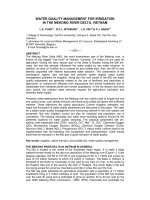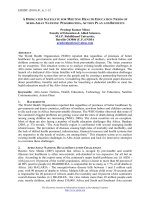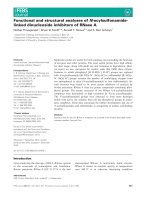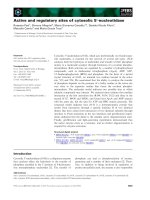Tài liệu Country Cooperation Strategy for WHO and the Republic of Yemen 2008–2013 pdf
Bạn đang xem bản rút gọn của tài liệu. Xem và tải ngay bản đầy đủ của tài liệu tại đây (1.1 MB, 64 trang )
of Yemen
EM/ARD/030/E/R
Distribution: restricted
Country Cooperation Strategy for
WHO and the Republic of Yemen
2008–2013
Republic
EM/ARD/030/E/R
Distribution: restricted
Country Cooperation Strategy for
WHO and the Republic of Yemen
2008–2013
ofYemen
Republic
© World Health Organization 2009
All rights reserved.
This health information product is intended for a restricted audience only. It may not be reviewed,
abstracted, quoted, reproduced, transmitted, distributed, translated or adapted, in part or in whole, in
any form or by any means.
The designations employed and the presentation of the material in this health information product
do not imply the expression of any opinion whatsoever on the part of the World Health Organization
concerning the legal status of any country, territory, city or area or of its authorities, or concerning the
delimitation of its frontiers or boundaries. Dotted lines on maps represent approximate border lines for
which there may not yet be full agreement.
The mention of specic companies or of certain manufacturers’ products does not imply that they
are endorsed or recommended by the World Health Organization in preference to others of a similar
nature that are not mentioned. Errors and omissions excepted, the names of proprietary products are
distinguished by initial capital letters.
The World Health Organization does not warrant that the information contained in this health information
product is complete and correct and shall not be liable for any damages incurred as a result of its use.
Document WHO-EM/ARD/030/E/R/03.09
Design by Pulp Pictures
Printing by YAT Advertising
Contents
Abbreviations 5
11
33
Section 2. Country Health and Development Challenges
Section 4. Current WHO Cooperation
Section 1. Introduction
Section 3. Development Cooperation and Partnerships
Section 5. Strategic Agenda for WHO Cooperation
29
29
30
31
43
44
44
13
13
13
15
16
26
35
35
36
37
37
38
3.1 Development assistance and aid ow
3.2 Development partners
3.3 Coordination mechanism
3.4 Development assistance: challenges and opportunities
5.1 Introduction
5.2 Priorities for collaboration with Yemen
5.3 Strategic directions for WHO support
2.1 Geography
2.2 Political and administrative overview
2.3 Economic, demographic and sociocultural aspects
2.4 Government and partner response to economic development challenges
2.5 Health
2.6 Major health development challenges for the next 5–6 years
4.1 Introduction
4.2 Brief review of WHO presence in the country
4.3 Human resources
4.4 WHO programme of technical cooperation
4.5 Collaboration with other development partners
4.6 Strengths and weakness of WHO cooperation
7
27
41
Country Cooperation Strategy for WHO and Yemen
49Section 6. Implementing the Strategic Agenda: Implications for WHO
51
56
6.1 Implications for the country ofce
6.2 Implications for the Regional Ofce and headquarters
Annexes
57
59
60
1. Members of the CCS team and list of persons met by the team
2. Health sector funding with donor support
3. Matrix of health programmes and projects supported by development
partners in Yemen
57
5
Abbreviations
BDN Basic development needs programme
CCA Common Country Assessment
CCS Country Cooperation Strategy
CMH Commission on Macroeconomics and Health
DFID Department for International Development (United Kingdom)
EC European Commission
EPI Expanded Programme on Immunization
FAO Food and Agriculture Organization of the United Nations
GCC Gulf Cooperation Council
GDP Gross domestic product
GTZ Deutsche Gesellschaft für Technische Zusammenarbeit
HMIS Health management information system
HIV/AIDS Human immunodeciency virus/acquired immunodeciency syndrome
ICC Interagency Coordinating Committee
JICA Japanese International Cooperation Agency
MDGs Millennium Development Goals
NPO National professional ofcer
PAPFAM Pan Arab Project for Family Health
SSA Special services agreement
UNDAF United Nations Development Assistance Framework
UNDP United Nations Development Programme
UNFPA United Nations Population Fund
UNHCR Ofce of the United Nations High Commissioner on Refugees
UNICEF United Nations Children’s Fund
USAID United States Agency for International Development
WB World Bank
WFP World Food Programme
WHO World Health Organization
YR Yemeni rials
Introduction
1
Section
9
Section 1. Introduction
The Country Cooperation Strategy (CCS)
reects a medium-term vision of WHO for
technical cooperation with a given country
and denes a strategic framework for
working in and with the country. The CCS
aims to bring together the strength of WHO
support at country, Regional Ofce and
headquarters levels in a coherent manner to
address the country’s health priorities and
challenges. The CCS process examines the
health situation in the country within a holistic
approach that encompasses the health
sector, socioeconomic status, determinants
of health and national policies and strategies
that have a major bearing on health. The
exercise aims to identify the health priorities in
the country and place WHO support within a
framework of 4–6 years in order to strengthen
the impact on health policy and health system
development, as well as the linkages between
health and cross-cutting issues at the country
level. The CCS as a medium-term strategy
does not preclude response to other specic
technical and managerial areas in which the
country may require WHO assistance.
The CCS takes into consideration the
work of all other partners and stakeholders
in health and health-related areas. The
process is sensitive to evolutions in policy
or strategic exercises that have been
undertaken by the national health sector
and other related partners. The overall
purpose is to provide a foundation and
strategic basis for planning as well as to
improve WHO’s collaboration with Member
States towards achieving the Millennium
Development Goals (MDGs).
This strategy document for 2008–2013
follows the previous CCS for Yemen, covered
the period 2002–2007. Its formulation is
the result of analysis of the health and
development situation and of WHO’s
current programme of activities. During its
preparation, key ofcials within the Ministry
of Public Health and Population as well as
ofcials from various other government
authorities, United Nations agencies,
nongovernmental organizations and private
institutions were consulted (Annex 1). The
critical challenges for health development
were identied. Based on the health
priorities of the country, a strategic agenda
for WHO collaboration was developed.
Country Health and
Development Challenges
2
Section
13
Section 2. Country Health and Development Challenges
2.1
Geography
The Republic of Yemen is located in the
southern part of the Arabian Peninsula.
It is a young nation-state created through
the unication of the Yemen Arab Republic
(North Yemen) and the People’s Democratic
Republic of Yemen (South Yemen) in 1990.
The geographical topography is varied
and ranges from high mountainous
regions to deserts and coastal terrain. The
population is around 23 million, who inhabit
110 000 settlements over an area of 527 970
square kilometres. Around 73.5% of the
population lives in rural areas.
2.2
Political and administrative
overview
The political system in Yemen is democratic
and is based on partisan pluralism. Since
the unication of the country, three rounds
of parliamentary elections and two rounds
of presidential elections have been held.
The country has 21 administrative and
geographical units called governorates,
which are further divided into 334 districts.
Law no. 4 of 2000 on Local Authority
provides a framework for decentralization,
which entails elections of local councils
at governorate and district levels. These
were held for the rst time in February
2001. Decentralization has empowered
communities, increased locally generated
revenues and had a positive impact on local
management of development projects.
Yemen is on course to become a member
of the Gulf Cooperation Council (GCC).
Currently, it participates in the GCC’s
committees on health, education, labour
and sports. The merger within the political
and economic system would provide new
scope and prospective for growth.
2.3
Economic, demographic
and sociocultural aspects
2.3.1 Economic aspects
Yemen faces multi-dimensional
challenges to continue sustaining economic
development and political reform and
achieving the Millennium Development
Goals for alleviating poverty. The country’s
economy is highly dependent on revenues
from oil production, with increasing
contributions from the shing, tourism
and agriculture sectors. Oil revenues
represented 28.7% of the total GDP in 2005
although there has been a decrease in the
rate of oil production by 2% every year. The
GDP growth rate fell from 5.1% in 2000 to
4.2% in 2003.
The current economic and development
challenges facing the country can be
summarized as: high population rate of 3%
annually with 74% of the population living
in rural areas in highly disbursed small
hamlets; low level of education; large gender
disparities; high unemployment and limited
job opportunities; fragile infrastructure with
limited roads and services; water scarcity;
and non-functional administrative and
nancial reforms.
14
Country Cooperation Strategy for WHO and Yemen
Country Cooperation Strategy for WHO and Yemen
2.3.2 Demographic aspects
According to the latest census estimates
(2004) the country has a population of
23 646 million as of mid 2007. The growth
rate of 3.1%, one of the highest in the world,
is expected to double in 24 years.
Factors contributing to the high growth
rate are the low use of contraceptives (23%)
and a fertility rate that has slightly decreased
over the past years from 6.5 in 1997 to an
average of 6.2 with a dependency ratio of
1:6. The population is predominantly young,
with 46% of the total population below
15 years of age. Life expectancy at birth
increased from 59.2 years in 2000 to 62.9 in
2004, and it is higher among women (62.8)
than men (61).
2.3.3 Gender aspects
The gender gap in Yemen, although
narrowing since 1999, is among the widest in
the world, with Yemen ranked at 117 among
177 countries (Human development report
2006) in terms of gender equality. Gender
relations are shaped by diverse religious,
cultural, social and political traditions. The
gender gap in primary school enrolment,
though decreasing from 37.2% in the early
1990s to 24.8% in 2002, has continued to lag.
There are only 52 female teachers for every
100 male teachers in cities, and in rural areas
females constitute only 8.6% of teachers.
Women in urban areas have better educational
opportunities and access to health care
and paid jobs and lower fertility levels, as
compared to rural women. 53% of working
women do not have control of their income.
Even though the Constitution gives women
full equality for participation in public life,
there are very few women in the government
(2 ministers), parliament (1 elected seat out of
305) and local councils (0.1%).
2.3.4 Poverty and human
development
Yemen is among the least developed
countries in the world. The Human
Development Report 2006 ranked Yemen as
150 out of 177 countries in terms of human
development indicators. 27% of people live
under the food poverty line and 42% are
under the national income poverty line. In
Yemen, poverty is more of a rural than urban
phenomena; 45% of the rural population
is poor, as compared to 31% of the urban
population. The prevalence of poverty also
varies among governorates, being highest
(49%) in Dhamar governorate and lowest
(15%) in Albaidha. Poverty is strongly
correlated with the number of children in
the family. In 1998–1999, the poverty rate
among families with 2 children was 29%,
rising to 48% among families with 8 children
(data from national household surveys).
There is a strong link between poverty
and poor health indicators, with a 2–7 fold
differential in health indicators when the
poorest quintile households are compared
to the richest, whereas geographic, rural/
urban and gender factors show a 1–2 fold
differential in health indicators (WHO Yemen
and PAPFAM 2005 based on the 2003
Family Health Survey data and Gwatkins
D et al. Socioeconomic differences in
health, nutrition and population in Yemen.
Washington DC, World Bank, December
2000).
Food insecurity affects 22% of
households with over 60% of the affected
population suffering from moderate hunger,
15
Country Cooperation Strategy for WHO and Yemen
and 46% of affected children under ve
years of age underweight. Unemployment
rose from 13.2% in 2002 to 14.8% in 2004.
The upward trend in the unemployment rate
is expected to continue.
2.4 Government and partner
response to economic
development challenges
2.4.1 Economic development
and poverty reduction
plans and strategies
In 1995, the Government of Yemen
adopted the economic, nancial and
administrative reform programme (EFARP).
The EFARP has coincided with the
implementation of the rst and second
national ve-year development plans
(1996–2000 and 2001–2005).
The Ministry of Planning and International
Cooperation, supported by the UN country
team in Yemen carried out an MDG Needs
Assessment and costing exercise in 2003.
This effort led to the development of an
MDG-based National Development Plan
and poverty reduction strategy paper for
the period 2006–2010 within the context of
the government’s strategic vision for 2025.
The strategic vision is as follows.
Improving the demographic and health
conditions
Eliminating illiteracy by increasing
school enrolment for basic
education, specically for girls
Raising per capita income by
diversifying the economic base
At the same time, the United Nations
Common Country Assessment (CCA) identied
the following four underlying reasons for the
poor outcome of development interventions in
Yemen.
Lack of transparency and participation
Insufcient progress towards
empowerment of women and children
Inequitable and unsustainable
use of water resources
Rising unemployment in the
face of population growth
2.4.2 Objectives of development
plans and response to the
Millennium Challenge
The third ve-year development plan
(2006–2010) aims at achieving stable and
sustained economic growth and creating job
opportunities as well as poverty reduction. A
set of strategies have been developed in the
areas of: nancial and administrative reform;
good governance; liberation of economy;
human resource development; women’s
empowerment; social protection for the
needy; encouraging partnerships, private
and foreign investments; and strengthening
the role of the local authorities.
To achieve the targets of the MDGs, a
public investment of US$ 57.6 billion is
required over the period 2006 to 2015,
equivalent to US$ 2500 per capita.
Assuming that national resources can cover
at least US$ 20 billion of the required capital
and running costs, the funding gap declines
to US$ 37.6 billion, or around US$ 160 per
16
Country Cooperation Strategy for WHO and Yemen
Country Cooperation Strategy for WHO and Yemen
capita on an annual basis. Given the very
low current levels of ofcial development
assistance per capita received by Yemen,
concerted national efforts, including painful
policy reforms, are needed.
2.5 Health
2.5.1 Health overview
Yemen faces major challenges to
improving the health status of its population
that go beyond the health sector. As noted
previously, poverty, food insecurity and high
illiteracy, especially among females, are
major contributing factors to poor health
as are limited access to drinking-water and
sanitation. The health indicators are indeed
alarming. Table 1 shows the trend of some
of the indictors.
2.5.2 National health policy
The health and population sector’s
objectives according to the third ve-year
development plan are as follows.
Strengthening the national health system
Combating epidemics, endemic
infectious diseases and reducing
morbidity and mortality rates
Improving the health care delivery system
The areas of priority within the plan are
listed below.
Strengthening the health system in its
entirety
Reducing maternal, neonatal, infant and
child mortality
Enhancing health, demographic
and environmental education
Reducing morbidity and mortality
attributed to endemic and sexually
transmitted diseases including HIV/AIDS
Improving the quality of health services
and increasing their utilization
Core indicators 1992 1997 2003
Prevalence (%) of underweight children (under ve
years of age)
30 46 46
Under-ve mortality rate (per 1000 live births) 122 105 102
Infant mortality rate (per 1000 live births) 83 75 75
Children 1 year old immunized against measles (%) 50 43 54
Maternal mortality ratio (per 100 000 live births) 800–1000* 351 365
Births attended by skilled health personnel (%)
16 22 25
Contraceptive prevalence rate (modern) (%) 6 10 13
Population with sustainable access to an improved
water source (%)
35 37 48
Population with access to improved sanitation (%)
27 31 31
Table 1. Trend of selected health indicators
Source: 1992 and 1997 estimates are from WHO/EMRO surveys and 2003 estimates are from the Family Health Survey
(PAPFAM 2004)
* Estimate from National population policy, problems and challenges, NPC, Sana’a, 2001
17
Country Cooperation Strategy for WHO and Yemen
Improving the safety and reliability
of blood transfusion services
Improving the access and quality
of emergency services including
emergency obstetric care
2.5.3 Organization of the health
sector
The Ministry of Public Health and
Population is the organization responsible
for the health sector and is one of the
largest public employers in the country.
However, there are a number of other
public organizations involved in nancing,
planning and provision of health services.
These include the Ministry of Finance,
Ministry of Planning and International
Cooperation, Ministry of Civil Service, the
two autonomous hospitals, the Health
Manpower Institutes and the military and
police health services.
The organizational structure of the
Ministry of Public Health and Population
has not been updated for some time. Core
functions such as policy analysis, strategic
planning, performance evaluation and
monitoring and intersectoral coordination
are underdeveloped. Exercises such as
health expenditure review and national
health accounts have been conducted in
the country but have not provided quality
outcomes useful to inform policy-making.
2.5.4 The public health system
Overview
The public health system in Yemen is
based on the primary health care approach
adopted in the late 1970s. Health care
services are provided on a traditional three
tier system. Health units provide the most
basic curative and preventive care within
a catchment area of 3000 to 5000 people.
These units are supposed to be backed
up by primary health care centres staffed
by a physician and other para-medicals
and include laboratory and X-ray facilities.
According to the structure of the primary
health care system, at the secondary
level, the district and governorate inpatient
facilities should offer more sophisticated
diagnostic and curative services. The
tertiary level facilities consist of major
urban-based hospitals that also serve as
teaching hospitals for the medical faculties
in main cities.
The health system in Yemen suffers from
shortcomings in structure and organization,
low staff morale, low quality of health
care, shortages of essential medicine, and
insufcient government budget. These are
compounded by irrational use of health
care, lack of equity in facility distribution
and human resources, as well as a lack of
a formal referral system or of integration of
services at the level of delivery of care.
Health services infrastructure
Health facilities have expanded
signicantly, from 1210 health units and
health centres and 168 hospitals in 1990 to
about 2700 health units and 172 hospitals
in 2004. Coverage with health services,
although improving, does not cover
more than 30% of the rural population
or more than 45% of the total population.
According to the third ve-year plan, there
are currently about 3287 health facilities
in Yemen; 66.5% are health units, 11.6%
health centres and 6.4% are hospitals. Only
18
Country Cooperation Strategy for WHO and Yemen
Country Cooperation Strategy for WHO and Yemen
20% of the total health workers in the public
health sector, while the remaining 80% of
the health workers are concentrated in the
urban areas. A study carried out by Health
Systems 20/20 during the same period
indicates that health services had reached
only 38% of the population as a whole.
Human resources
There are 44 823 health personnel in
Yemen (World health statistics 2006). 53%
are technicians and 30% are physicians.
About 8% of the workers are expatriates.
Information is not available on the number
of female health workers. The distribution of
health personnel is not equitable (Table 2).
Aden, with population of half a million, has
10.7% of the health workforce, but Taiz, with
a population of 2.4 million, has only 8.3%.
Training of health staff is not based on
demand or on a well deliberated vision.
The output of health workforce training
institutions and faculties of medicine,
nursing and other health elds is not
consistent with the Ministry of Public Health
and Population’s plans for their deployment.
There are ve medical schools, three schools
of laboratory, three schools of nursing,
two schools of pharmacy, four schools of
dentistry, one school of dental industry,
two higher institutes for health sciences,
19 health institutes in the governorates and
two medical councils for specialization.
The total number of students studying in
various courses at the Higher Institutes of
Health Sciences in Aden and Sana’a are
853 and 1068, respectively. Education is
free, and there is great deal of pressure on
the medical schools and health institutions
to admit a large number of students, leading
to poorly trained graduates. The curricula of
these institutions have not been updated
to take into account the latest Ministry of
Public Health and Population policies and
strategies.
Health information system
During the past 10 years a number of
health-related surveys have been carried
out, mostly with external assistance. These
include a population census in 2004, health
survey in 2003, household budget surveys
in 2003 and the UNICEF-supported multiple
indicator cluster survey in 2001 and 2003.
However, in the Ministry of Public Health and
Population, there is no database available
to use as a basis for decision-making
related to allocation of nancial and human
resources, control of communicable and
noncommunicable diseases, or information
on donor support. Data collected in most of
the various health facilities at all levels are not
accurate and sending of statistical reports
from the periphery to the central level is not
regular. There is no budget allocated for
the health information system. Many other
problems also face the health information
system, including lack of supervision and
monitoring, lack of sufcient training in this
area, and lack of computerization to date. A
number of partners and supporting agencies
have established data collection systems in
their respective areas of work to meet the
management needs of their programmes.
Special care must be taken to disaggregate
the data by sex when collecting, developing
and utilizing health information for policy
formulation.
19
Country Cooperation Strategy for WHO and Yemen
Health care nancing
Funding of the health sector is one
of the most critical issues affecting the
performance of the national health system.
The issue is problematic, as often only 50%
or less of the already low budget is actually
released.
The different sources of funding and their
contribution to the health sector are as
follows:
Table 2. Distribution of various categories of health workforce in different
governorates (2004)
Source: Statistical Yearbook of the Ministry of Public Health and Population, 2005
Governorate Population Population
below
poverty (%)
Physicians
per 1000
population
Nurses
per 1000
population
Midwives
per 1000
population
Medical
assistants
per 1000
population
Sana’a City 1 816 389 23 0.06 0.07 0.03 0.01
Sana’a 1 485 979 36 0.11 0.13 0.05 0.05
Aden 554 111 30 1.46 2.03 0.56 0.17
Taiz 2 507 873 56 0.19 0.31 0.05 0.03
Al-Hodeidah 2 136 36 36 0.05 0.19 0.09 0.02
Iaheg 694 243 52 0.30 1.05 0.31 0.19
Ibb 2 192 419 55 0.11 0.15 0.06 0.03
Abyan 458 810 53 0.20 1.32 0.34 0.27
Dhamar 1 308 077 49 0.05 0.18 0.09 0.04
Shabwah 500 208 43 0.29 1.09 0.14 0.22
Hajjah 1 497 547 36 0.06 0.14 0.03 0.03
Al-Baidah 616 520 36 0.16 0.20 0.03 0.08
Hadramout 927 215 43 0.28 0.45 0.29 0.28
Saadah 653 928 27 0.05 0.14 0.05 0.05
Al-Mahweet 490 983 36 0.16 0.24 0.09 0.06
Al-Mahrah 77 341 43 0.67 3.52 0.57 0.37
Mareb 249 109 36 0.15 0.46 0.16 0.09
Al-Jawf 476 505 36 0.03 0.04 0.10 0.04
Amran 1 074 666 36 0.05 0.13 0.11 0.03
Al-Daleh 439 839 36 0.17 0.57 0.14 0.14
Households: 57%
Ministry of Finance: 25%
Foreign assistance: 11%
Parastatal bodies: 4%
Private employers: 4%
Yemen has very high out-of-pocket
expenditure on health (57.6%) compared
with other countries in the Region. The
20
Country Cooperation Strategy for WHO and Yemen
Country Cooperation Strategy for WHO and Yemen
registration of fees and accounts are
not uniform, and the problems may be
accentuated by different parts of the country
being supported by different donors and
developing at different paces.
Based on the 2003 document on health
expenditure estimates, 29% of the health
expenditure goes for treatment abroad;
however, 95% of expenditure for treatment
abroad is paid for by the citizens themselves.
The estimated private expenditure on health
as percent of total expenditure is around
72% (Table 3).
More than 50% of the total public
spending on health is consumed by salaries
of the staff. However, salaries and wages
have declined in recent years resulting in
low morale among staff. Because of lack
of funds, facilities are ill equipped and
do not have essential commodities and
medicines.
With support from WHO and GTZ,
feasibility studies have been undertaken on
establishing a system of health insurance.
However, detailed regulations, scientic
standards, trained personnel, monitoring
and preparation of selected health facilities
are needed to make the system operational.
A draft bill for establishing national health
insurance has been approved by the
cabinet and will be taken up for debate in
parliament.
Role of the private sector in health
There are more than 9000 private health
facilities in Yemen, of which nearly 1800 are
concentrated in the main cities, including 56
private, general and specialized hospitals,
and more than 1750 pharmacies and
clinics. The growth in private health care
started to accelerate after 1990, mainly
driven by deteriorating quality and low
coverage of public services. It is estimated
that the private sector covers about 70%
of all hospital care in the country. Work on
legislation to cover the private health care
started in 1999, but establishment and
enforcement of regulations, standards,
procedures and inspecting services have
proven to be challenging.
2.5.5 Health sector reform
District health system and
decentralization
The Ministry of Public Health and
Population has embarked on a reform
programme, starting in 1998. The health
sector reform and decentralization of the
health sector are occurring in an overall
context of public sector reform based
on decentralization, democratization,
civil service modernization and nancial
restructuring. In 2002, the district health
system was introduced as the core of the
national health sector reform, which is based
on the primary health care approach. The key
element of the reform is the establishment
of a district health system where other
elements such decentralization, community
participation and intersectoral cooperation
could be realized. The reform has called for
redening the role of the public sector and
encouraging the participation of the private
sector and putting more focus on: donor
coordination; community co-management;
cost sharing; essential medicines policy
and realignment of the logistics system;
outcome-based management systems
from central to community levels; hospital
21
Country Cooperation Strategy for WHO and Yemen
Indicator 1999 2000 2001 2002 2003
Total expenditure on health as % of gross domestic
product
4.9 5.3 5.5 5.1 5.4
General government expenditure on health as % of
total expenditure on health
32.7 28 29.2 28.1 27.8
Private expenditure on health as % of total
expenditure on health
67.3 72 70.8 71.9 72.2
General government expenditure on health as % of
total government expenditure
6.7 6 6.7 5.1 5.6
Out-of-pocket expenditure as % of private
expenditure on health
96.3 96.1 96.6 96.7 95.5
Per capita total expenditure on health at average
exchange rates (US$)
18 24 26 27 32
Per capita government expenditure on health at
average exchange rate (US$)
7 10 11 10 13
Table 3. Selected indicators of health expenditure and national health accounts
Source: The World Health Report 2006
autonomy; intersectoral cooperation; and
sector-wide approaches to donor funding.
The Ministry of Public Health and
Population has developed an essential
service package for the district health
system to improve the health services
delivered by the rural hospitals, health
centres and health units. Also, a publicly
funded supply and logistic system has
evolved to support the district health system
through the national medicine programme.
Increasing numbers of districts in Yemen
are adopting the district health system.
There are achievements in the district health
system and decentralization, particularly in
the donor-supported health facilities.
Health sector review
After several years of implementation to of
health sector reform, the Ministry of Public
Health and Population and its development
partners in the health and population sector
have engaged in a review process, consisting
of three phases: dening the status quo,
bench-marking, and setting the policies.
The review process is being carried by a
national task force team assisted by local
and international experts and overseen by
a Steering Committee made up of Ministry
of Public Health and Population leadership
and representatives of the partner agencies.
The rst phase had just been completed
through comprehensive and systematic
collection of information, including a nation-
wide survey and series of workshops and
focus groups. The expected outcomes of
the health sector review are as follows.
A strategy that outlines prospective
policy reforms in the health sector
Political commitment and sufcient
resource allocation to implement these
reforms
Consensus between stakeholders
on the mechanism and approaches
to implement the strategy
22
Country Cooperation Strategy for WHO and Yemen
Country Cooperation Strategy for WHO and Yemen
At the conclusion of the review process,
the second national health development
conference will be held and the updated
reform strategy based upon consensus of
national and international stakeholders will
then be submitted for formal approval by
the Government of Yemen.
2.5.6 Social determinants of health
Education
The growth in school enrolment in basic
education has been signicant, increasing
of from 73% in 1990 to 87% in 2004,
exceeding the average among low-income
countries. Similarly, there has been an
increase in enrolment of girls, from 28% to
63% in the same period.
The illiteracy rate on average has declined
from 47% in 2000 to 28% in 2004. However,
it is much higher among females than
among males; in 2004 the average illiteracy
rate among women was 41.5% declining
from 64.1% in 2000, compared to 14.5%
among males.
Food and nutrition
Approximately one third of the population
remains undernourished; this proportion
rises to 46% in children under ve years.
Stunting among children under ve reaches
as high as 58%, and anaemia prevails in
37% of pregnant women.
According to the Family Health Survey
2003, 53.1% of children under ve years in
rural and urban areas suffer from stunting
and 12.4 suffer from wasting: 31% and 3%
are severely stunted and severely wasted,
respectively. Nearly half (45.6%) of children
under ve are underweight, and 15.2% are
severely underweight. These percentages
are much higher in rural areas.
Water and environmental health
There is an acute scarcity of water
throughout the country. The per capita water
supply is 2% of the world average (198 cubic
metres per person) and the consumption
of water for agriculture purposes is one of
the highest. Only 43% of the population
has access to safe drinking-water. With the
population projected to double in less than
three decades, water availability per capita
is expected to fall by one third.
The Ministry of Public Health and
Population has no department or unit to
deal with environmental health. Since the
Ministry of Public Health and Population
has the responsibility to monitor public
health safety with respect to all factors
including the environment, there is grey
area in role of Ministry of Public Health
and Population. Even if the responsibility
for environmental health monitoring is with
other ministries, there is a gap and absence
of effective mechanism for coordination
and collaboration between the Ministry
of Public Health and Population and other
concerned government bodies. In view
of critical shortcomings in sanitation and
control of environmental health hazards
and their impact on health, it is crucial
for the health sector to monitor and
incorporate the environmental risk factors
in health development. As well, the use
of pesticides, especially on khat leaves,
requires good environmental monitoring.
WHO collaboration should support the
responsible ministries in matters related to
environmental health.
23
Country Cooperation Strategy for WHO and Yemen
Consumption of khat
The consumption of khat, a natural
stimulant resembling amphetamines, is
increasing. It is estimated that 70%–90%
of adult males, 30%–50% of adult females
and 15%–20% of children under the age
of 12 consume khat on a daily basis. Up to
50% of household income may be allocated
to the daily khat needs of the head of the
household.
According to the Central Bank of Yemen,
in 2005 the production of khat rose 6.7%
and accounted for 5.8% of Gross Domestic
Product (GDP). According to the World
Bank and other sources, cultivation of this
plant plays a dominant role in Yemen’s
agricultural economy, constituting 10% of
GDP and employing an estimated 150 000
persons while consuming an estimated
30% of irrigation water and displacing land
areas that could otherwise be used for
exportable coffee, fruits and vegetables.
(Country prole: Yemen. Washington DC,
Congressional Federal Research Division,
December 2006). Despite implications for
health, social and economic development,
the issue of khat remains largely a taboo
subject in national debates.
Refugees
According to UNHCR, around 10 000
people a year are believed to cross from
Somalia to Yemen. The total number of
refugees is estimated to be 200 000,
coming mostly from Somalia, Ethiopia and
Eritrea. The majority of the refugees live in
urban areas of Sana’a, Aden, Taiz, Hodeida,
Dhamar and Mukalla. Registered refugees
in Sana’a and Aden are provided with basic
health care and education.
2.5.7 Reproductive health
Maternal health
The maternal mortality ratio of 365 per
100 000 live births (2007) is among the
highest in the world. The high maternal
mortality ratio is related to high fertility,
limited antenatal care (31% of urban and
62% of rural pregnant women do not
receive any antenatal care), poor nutrition
and illiteracy. Deliveries attended by
qualied health personnel are as low as
25%. The direct causes of 70% of maternal
deaths were postpartum haemorrhage,
difcult labour, ruptured uterus, toxaemia
of pregnancy, puerperal sepsis and
complications resulting from abortions;
30% of the deaths were due to malaria
and severe anaemia (UNICEF, 2003). The
majority of deliveries (77.2%) took place in
the home, about 16.1% in general hospitals
and 3.5% in private hospitals.
The prevalence of modern contraceptive
use among women of childbearing age
ranges between 3% and 18%. Most women
(82.2%) not using these methods attribute
the reason to health problems, while 4.9%
attribute lack of use to inaccessibility
of family planning methods/services.
According to the Family Health Survey 2003,
family planning services are only available
to one third of married women. The use of
family planning is directly correlated with
the level of education of women.
The programmes for reproductive
health and family planning have received
considerable support from other partners
in addition to WHO. A national reproductive









